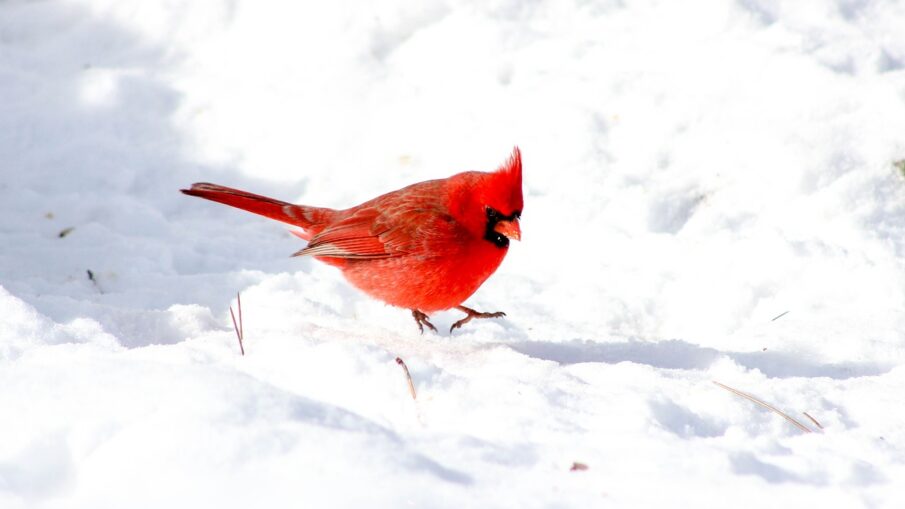The sight of Canada geese heading south becomes familiar as winter approaches. But even as temperatures drop, there are various bird species that remain in Frederick. Some species even migrate here for the winter. Here are five different songbird species to watch for this coming winter:
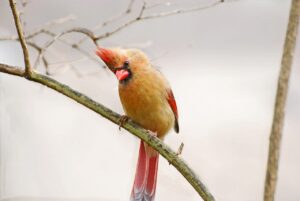
- Northern cardinal. This species is very easy to recognize and appears frequently on holiday cards. According to the Cornell Lab of Ornithology, male northern cardinals are completely bright red, except for a black mask that covers part of the face, chin, and throat. Female cardinals are a duller olive-brown, but they are easy to identify as they have the same size, shape and thick red bill as the males. Although the northern cardinal can be seen year-round, its plumage is especially stunning against a backdrop of fresh snow.
- Blue jay . Like the northern cardinal, the blue jay lives in Frederick year-round
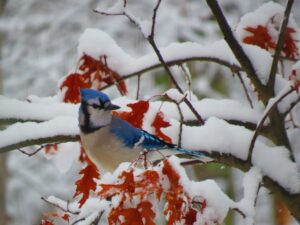
Blue jay and looks just as brilliant in the snow. But unlike the cardinal, male and female blue jays look exactly alike, with iridescent blue feathers and wings checkered in white, black and blue. According to the Cornell Lab of Ornithology, the blue color is not caused by pigment, but by refracted sunlight. The blue jay is also larger than the northern cardinal and possesses a longer bill. Blue jays and northern cardinals have similar diets, so you might be able to see the two species sharing a birdfeeder.
- Dark-eyed junco. While this species is not as flashy as the blue jay or northern cardinal, it has its own charms.
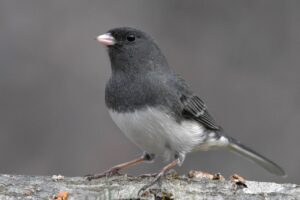
Dark-eyed junco The dark-eyed junco is a small, round bird that migrates to Frederick and throughout America for the winter. As the name suggests, the dark-eyed junco has dark eyes. According to the Cornell Lab of Ornithology, the dark-eyed junco also has a pink bill and white outer tail feathers that flash open. The only difference between male and female dark-eyed juncos are the colors—males are dark gray, while females are brown. It frequently gathers in flocks that flit between trees or forage on the ground. On dreary winter days, the sight of a flock darting through the gray sky is bound to be heartwarming.
- White-throated sparrow. Another winter visitor, the white-throated sparrow is brown with distinctive facial
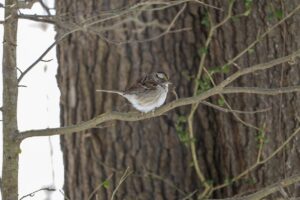
White-throated sparrow markings: a white patch on the throat, a bright yellow spot between the eyes, and alternating black stripes on the crown. Male and female white-throated sparrows look identical. According to the Cornell Lab of Ornithology, the white-throated sparrow has two different color variations: white-striped and tan-striped. White-striped birds have white stripes that alternate with the black stripes on the crown, while tan-striped birds have tan stripes in place of the white stripes on the crown. According to the Cornell Lab of Ornithology, the white-throated sparrow also has a distinctive whistled song, which can be heard even in the winter.
- Ruby-crowned kinglet. This tiny bird is also a winter visitor, named
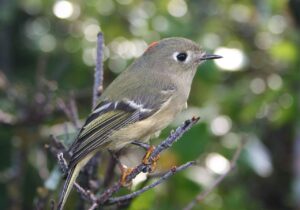
Ruby-crowned kinglet for the ruby crown on males. Although females lack the ruby crown, their appearance is identical to the males in all other aspects; both have the same green-gray color and two white wing bars. Despite being named for its ruby crown, the ruby crown is not easy to see because it is usually hidden, especially in the winter when breeding season is long over. According to the Cornell Lab of Ornithology, it is easier to identify the ruby-crowned kinglet by its white eye-ring, white wing bars and the energetic flicking of its wings. But because the ruby crown is seldom visible to see, a glimpse of the crimson color is always a treat.
Amanda Tsai is a dual enrollment student at FCC. She enjoys drawing, reading and writing. Tsai hopes that by writing for The Commuter, she can expand her writing experience and be more involved with the community at the same time.

